Six prescribed archaic statues
1/32
Earn XP
Description and Tags
Name | Mastery | Learn | Test | Matching | Spaced |
|---|
No study sessions yet.
33 Terms
When was the archaic period?
600-490BC
New York Kouros
Height? Date? Material? Location?
Height: 1.95m, so about life size
Date: c.590 BC
Material: Naxian marble
Location: Probably Attica but currently found in the Metropolitan Museum in New York
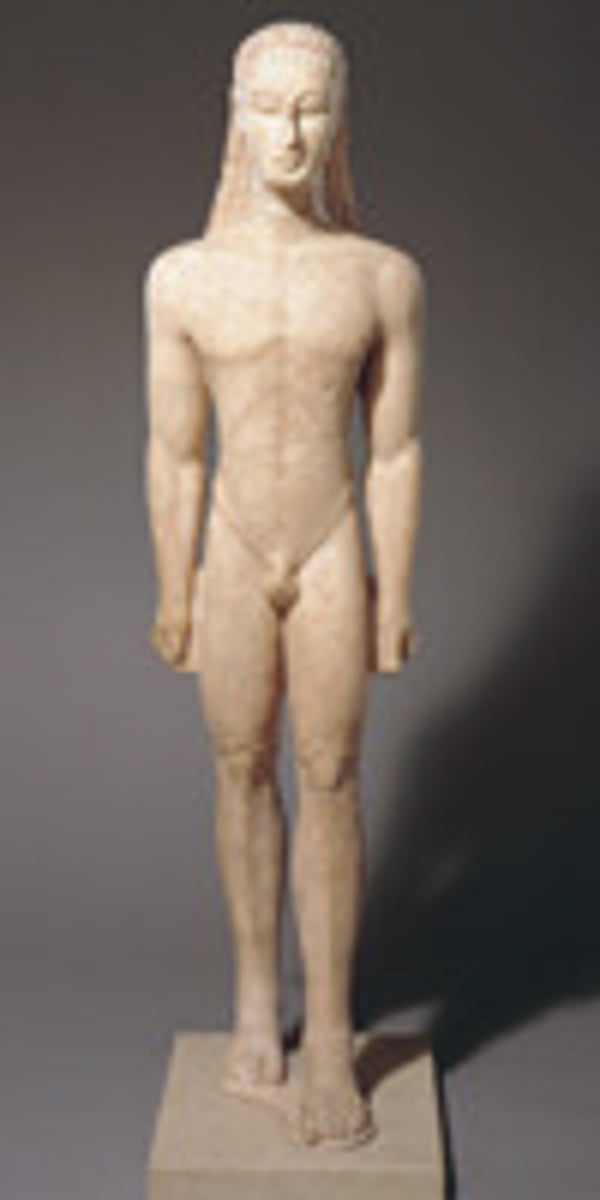
New York Kouros comparison with earlier figures
Egyptian figures from the time were more naturalistic and rounded but it still employs the Egyptian gridblock technique and has the stance (left foot forward, right foot back), size and use of hard stone.
New York Kouros features (5 points)
You can see the influence of the geometric period through the sculptor’s employment of symmetry and patterns e.g. the iliac crest uses a chevron, the pectorals, eyebrows and knees use gull wings.
Beaded hair for support due to the low tensile strength of the marble → Archaic feature
It is mostly free standing but still has some support e.g. bridge between the hands and thighs to give support
In the round but mainly frontal.
New York Kouros features analysis
Hint: what do its eyes and free standing nature suggest?
Smart History
The NYK is more symbolic than realistic because it is a display of arete and a didactic statue used to give an ideal of manhood and perfection. Its insectoid eyes are purposefully unnaturalistic to give a sense of other worldliness and the way they look beyond us gives a sense of transcendence. The statue is thought to be a funerary statue made to surpass lifetimes with its timeless nature. Its almost free standing nature gives it more autonomy and independence as it is free from the stone. This shows a daringness not seen in earlier Egyptian sculptures.
Scholar quotes on New York Kouros:
Woodford? MET?
Susan Woodford: 'Sacrificed the smooth naturalism of his Egyptian model for the sake of creating a more aesthetically satisfying work'
Metropolitan Museum: 'the artist was struggling to represent the complex anatomical details of the body'
Kleobis and Biton
Height? Date? Material? Location?
Height: 2.18m, slightly above life size
Date: c.580 BC
Material: Marble
Location: Delphi Archaeological Museum in Greece
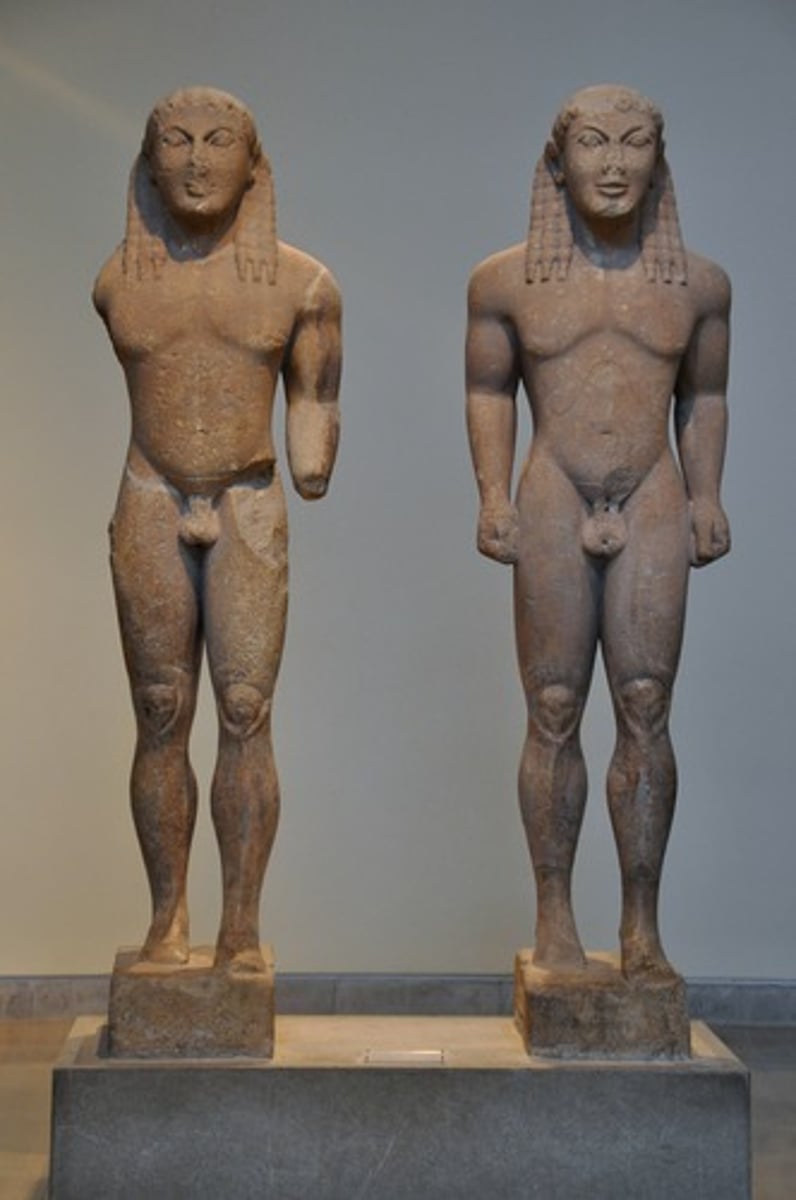
Kleobis and Biton narrative
KLEOS
The oxen for their mother’s cart did not arrive from the field in time so they pulled the cart 6 miles so their mother was not late to the festival for Hera. This displayed their arete and they preserved their family reputation (Piety and duty) and showed their selflessness for their mother and Hera.
The people of Argos put up kouroi of them at Delphi to commemorate them.
Kleobis and Biton features (7)
Gull wing eyebrows.
Long beaded hair across the shoulders to give support to the head due to low tensile strength of the marble.
Groove lines in the iliac crest and top of the abdominals.
Large thighs and buttocks.
Archaic smile almond eyes and naturalistic ears.
Tough flexed arms.
Inscriptions of plinths which identify them as Kleobis and Biton
Who sculpted Kleobis and Briton according to the inscription on the plinth?
Polymides of Argos
Kleobis and Biton feature analysis
The statues are more symbolic than realistic as the sculptor wants them to act as didactic statues that represent the Kleos and Strength of the brothers e.g. through the flexed arms and large thighs. Regarded as typical peloponnesian style: massive and muscular. Idealiesd display of arete. Less patterns e.g. less groove lines on the torso. Archaic smile to make statues look more alive.
Scholar quotes on Kleobis and Biton
Woodford? Boardman?
Woodford: archaic smile 'makes their faces look more alive' not to indicate they were happy
Boardman: 'idealised representations of the virtues of masculine strength and piety'
The Anavyssos Kouros
Height? Date? Material? Location?
Height: 1.94m, life size but slightly taller
Date: c.530 BC
Material: Marble
Location: Originally found in Attica, then sawn in half and smuggled to Paris in 1937 before being later returned to Greece
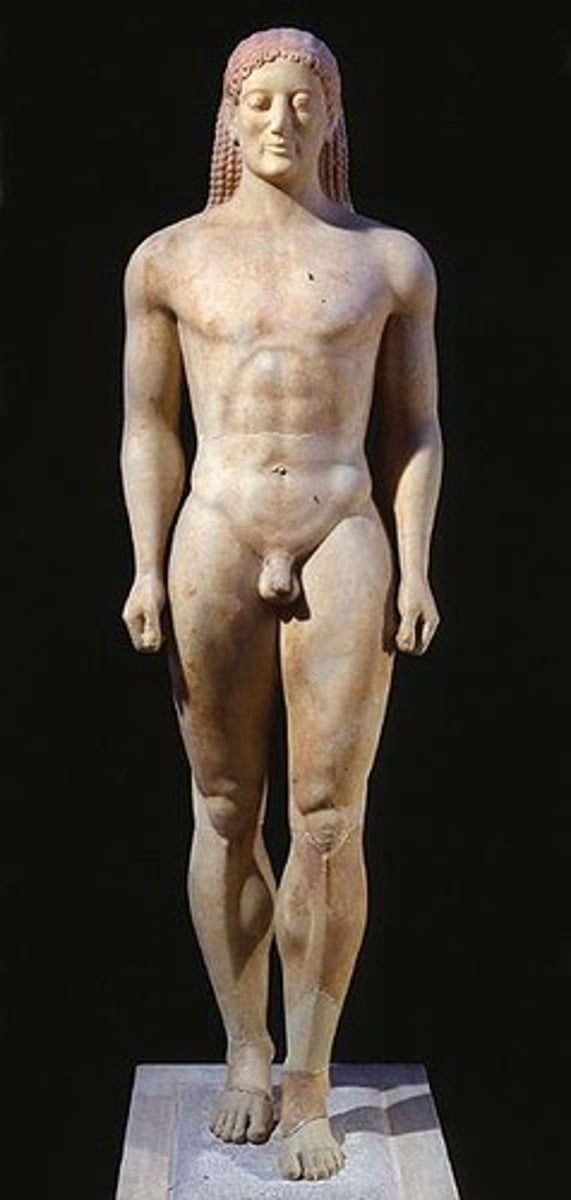
The Anavyssos Kouros features (6 points)
Rounded planes in cheeks, calves, thighs and knees make the statue have more integrated and naturalistic anatomy.
Volutes on the hair line.
Archaic smile.
Bridge support between hands and thighs.
Long beaded hair across the shoulders to give support.
Softened iliac crest.
The Anavyssos Kouros features comparison
More realistic with better proportions than previous sculptures but same pose and same hair as earlier kouroi. Improvement from earlier NYK as there are more rounded than flat planes. Still uses support with hands attached to the hips. Ears are no longer volutes they look like ears. Less groove lines.
Purpose of Anavyssos Kouros
Base inscription: 'Stay and mourn at the monument for dead Kroisos whom violent Ares destroyed fighting in the front line'
- To solidify/ensure his kleos (reputation)
- Display of arete/techne by the sculptor
- Display of arete of Kroisos
- Mention of Ares to deliver a strong narrative
Scholar quotes Anavyssos Kouros
Woodford: 'suggestive of soft flesh rather than hard stone'
The Aristodikos Kouros
Height? Date? Material? Location?
Height: 1.95m
Date: c.510-500 BC
Material: Marble
Location: Athens
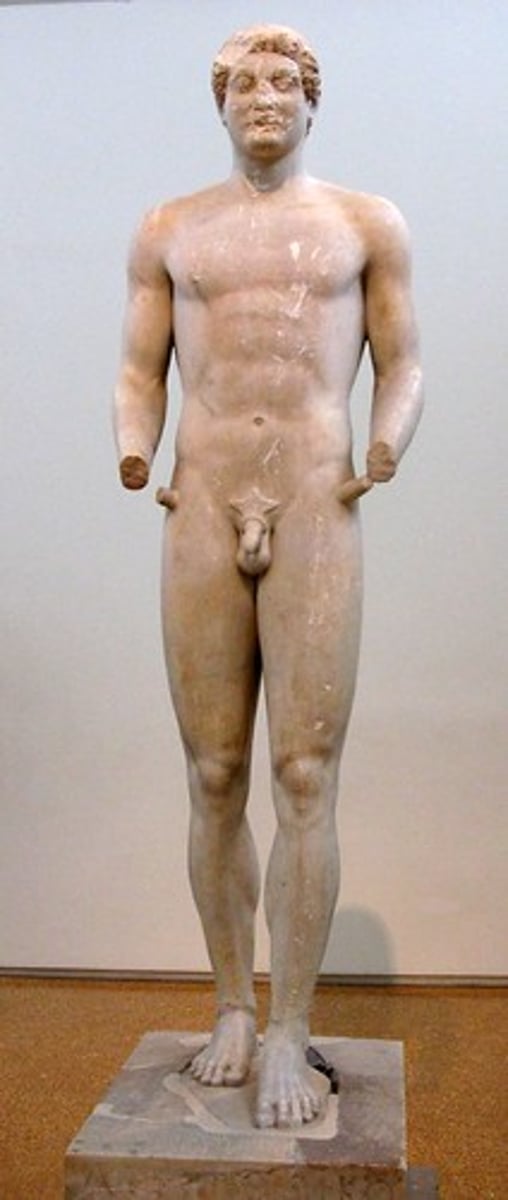
The Aristodikos Kouros features and comparison
Hair tied up in a plait around the head with volutes on the hair line.
Integrated features with rendered anatomy e.g. asymmetric bones and muscles, iliac crest, knees, calves.
Less geometric patterns but still volutes on hair and star on groin.
Movement away from support e.g. no long beaded hair and bent arms further away from thighs. However there is still a bridge between hands and thighs. Archaic smile, same pose.
Aristodikos Kouros Scholar quotes
Woodford: 'it makes the Anavyssos kouros look like an an 'inflated balloon in contrast' more realistic
Berlin Standing Goddess
Height? Date? Material? Location?
Height: 1.93m
Date: 570-560 BC
Material: Found covered in lead, marble
Location: Found in Attica, now located in Berlin
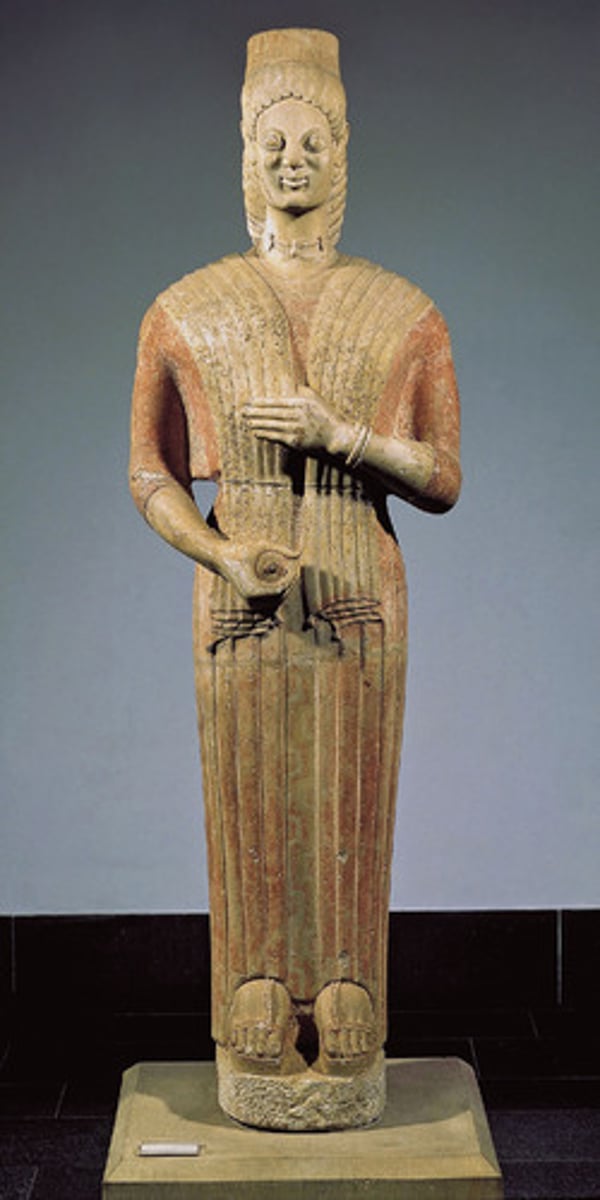
The Berlin Standing Goddess
What is she wearing and what is she holding?
She is wearing a chiton and a himation and holding a pomegranate (a symbol of fertility)
Berlin Standing Goddess features
What detail is shown in her facial features?
She breaks the frontal plane with her thumb behind the himation.
Asymmetric action arms.
Archaic smile and insectoid eyes
Scallop fringe.
Crown (polos) with lotus bud and meander patterns.
Catenary pattern on the back of her himation.
Polychromy on her drapery with red yellow and blue pigments used in battlement patterns.
Berlin Standing Goddess
What limitations/faults does she have?
Sandals not integrated very well into the rest of her body
Fluting in her chiton gives no sense of anatomy beneath her drapery
Primitive insectoid eyes and archaic smile make her less naturalistic
Berlin Standing Goddess features
Aesthetically pleasing? Yes or no?
YES: advances in naturalism in the asymmetric action arms, pleasing catenary pattern on the back of the himation, rounded planes e.g. facial cheeks, polychromy, catered to ancient audience who love patterns
NO: Primitive insectoid eyes are very unatural, sandals and feet are not very integrated, drapery is hanging
Berlin Standing Goddess Scholar quotes
Woodford: 'bright and alert face'
Neer: 'connotes fertility'
Peplos Kore
Height? Date? Material? Location?
Height: 1.17m, under life size
Date: c.530 BC
Material: Parian Marble
Location: Athens
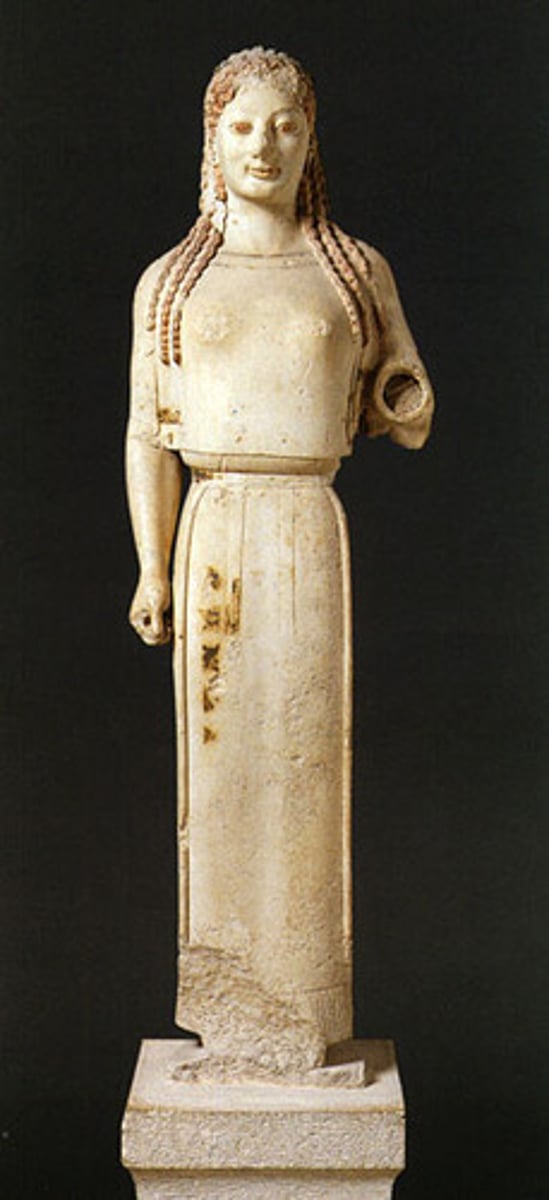
Peplos Kore features
She wears a peplos over a chiton. Rods rising out of her head and holes perhaps a crown was there? Holes in her ears for bronze earrings?
There is subtle fluting in her peplos but there are flat planes which give no sense of anatomy.
Asymmetric action actions breaking the frontal plane.
Archaic smile, gull wing eyebrows, rounded planes in her cheeks and on her torso give a sense of realism
Stylised braids to support her head.
Embroidery of animals seen in polychromy going down her dress no longer visible to the eye.
waist and breasts emphasised ,she represents ideal femininity
Peplos Kore irregularities
The sculptor shows the reaction of the body to movement of her arm with her head slighly turned to her left and her left shoulder being higher than her right. Moreover, the fall of her braids with her left braids being higher than her right
Peplos Kore Scholar quotes
Woodford: Peplos Kore irregularities 'convery a sense of the young and supple body it conceals'
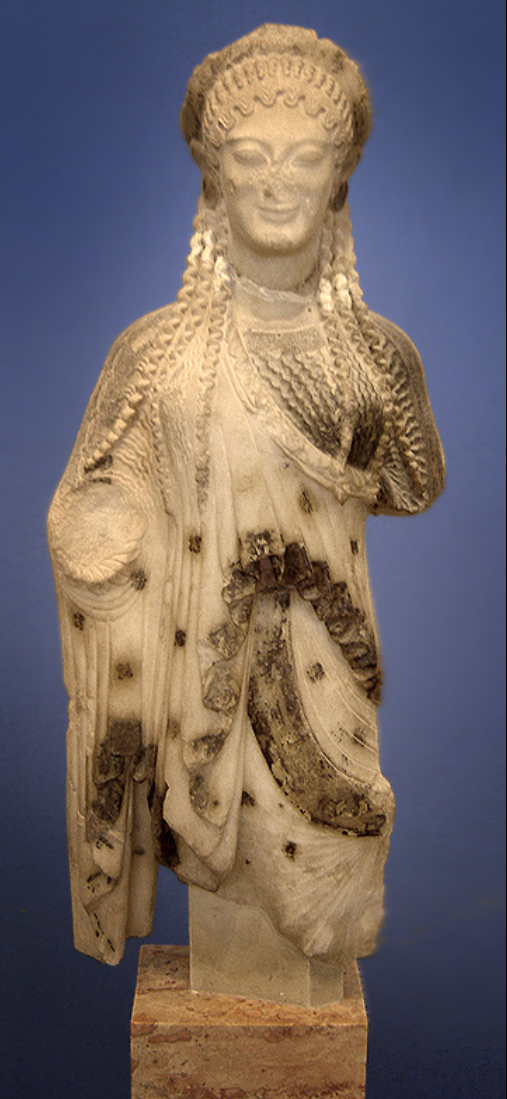
UNPRESCRIBED STATUE
Kore 675
Height? Date? Material? Location?
Height: 0.55m due to her loss of legs
Date: c.520 BC
Material: Marble
Location: Came from the Athenian Acropolis
UNPRESCRIBED STATUE
What makes Kore 675 aesthetically pleasing?
The reactive and naturalistic drapery which highlights the anatomy beneath it e.g. the tin crinkly chiton making the outline of her breasts visible, the diagonally draped heavy woollen cloak
Her asymmetric right arm, which has unfortunately, been fractured shows techne
The use of polychromy (it is now faded slightly) on the hem of her himation and the blue and red patterns still on her chiton
Stylised hair e.g. ringlets cascading over her shoulders, undulating fringe, series of tight curls topped by a Stephane
Rounded planes on her breasts
Archaic smile
UNPRESCRIBED STATUE
How does Kore 675 show advancements in archaic sculpture?
Her arms and legs have been fitted with threads in sockets
The greater appreciation for female anatomy
Naturalistic drapery